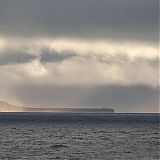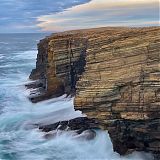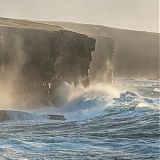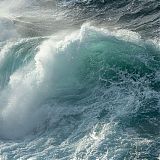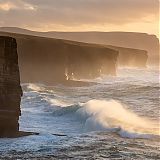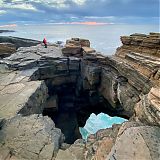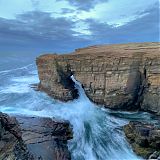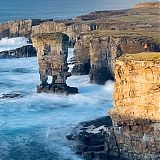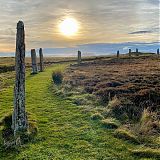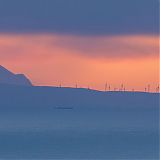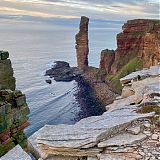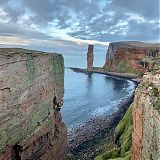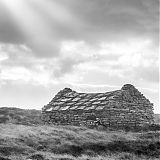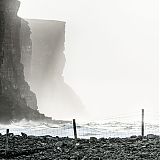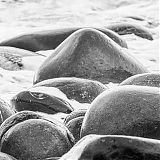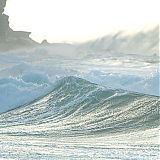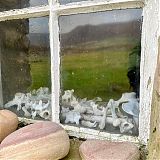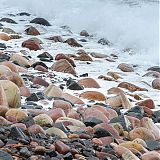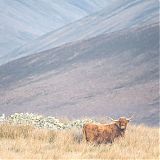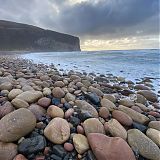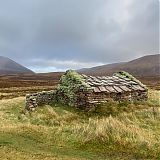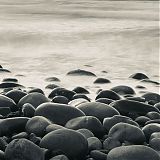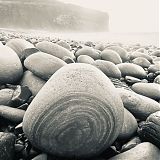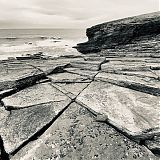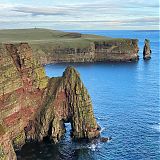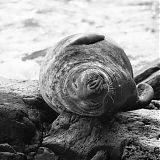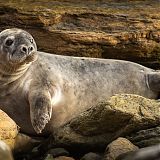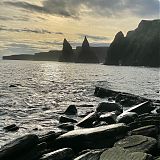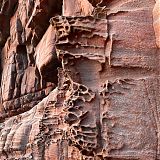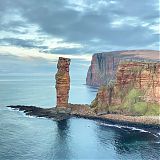Scotland – Orkney, Hoy and John O’Groats
Highlights include…
- Castle Sinclair
- Fabulous Birdlife
- Duncansby Head
- John O’Groats
- Stromness street photography
- Birsay Sound and the Earl’s Palace
- Neolithic sites
- Ring of Brodgar & Stones of Steness
- Marwick Head & Kitchener’s Memorial
- Yesnaby sea stacks and cliffs
- The Old Man of Hoy
- St John’s Head Sea Cliffs
Introduction
There’s a magic to Orkney that you begin to feel as soon as the Scottish mainland slips astern. Only a few short miles of ocean separate the chain of islands from Scotland’s north coast, but the Pentland Firth is one of Europe’s most dangerous waterways, a graveyard of ships that adds an extra mystique to these islands shimmering in the sea mists and thrashed by the wild Atlantic waves. The approach to by ferry gives us a great sense of place as we sail past a dramatic coastline of massive sea cliffs including the Old Man of Hoy, an improbably tall and slender sand stone sea stack. The Archipelago of Orkney consists of approximately 70 islands, 19 of which are inhabited. The landscape of Orkney is green and rolling, treeless with large skies and stunning skies. Occasionally in the winter there will be snow adding an extra touch of drama to the already bold vistas.
In addition to its important and atmospheric neolithic sites, Orkney is equally famous for its dramatic coastline and spectacular towering sea stacks. The distinctive sandstone layered coastline is colourful and full of texture, throw in some wild Orcadian weather and we have all the ingredients for some fabulous wave action and dramatic seascape photography! We have included a couple of nights at the beginning to explore Scotland’s North East tip visiting Duncansby Head and the dramatic Castle Sinclair located on Scotland’s east coast of Wick. Classic and inspiring vistas are seemingly at every turn as are the smaller, more intimate details to be found within the landscape. We will explore how to create abstract interpretations of the landscapes that we will be immersed in. For at least some of the time we will be encouraging participants to reach out of their comfort zone by trying some new and different techniques. We will aspire to balance our time in the field with post processing work including preparing images for the web/printing and reviewing/discussing our images in evening group sessions.
Rackwick Bay
People left and the houses became abandoned
At Burnmouth the door hangs from a broken hinge
And the fire is out.
The windows of shore empty sockets
And the hearth coldness.
At Bunnertoon the small drains are chocked.
Thrushes nest in the chimney.
Stars shine through the roof beams of Scar.
No flame is needed
To warm ghosts and nettles and rats
Dead Fires.
Poem by George Mackay Brown
Daily Itinerary
For full details please download the trip description PDF
Day 1: John O’Groats
WPH will arrange a transfer from Inverness to John O’Groats and our hotel close to the castle of Mey and Duncansby head. Inverness is well connected by train and flights. You will probably need to stay in Inverness the night before Day 1 as we hope to be driving North by mid-morning. You are welcome to drive yourself to our first night hotel and it will be possible to leave your car on the mainland when we sail to Orkney.
Hotel (D)
Day 2: Duncansby Head & Castle Sinclair
This morning we will rise early to catch a sunrise at Duncansby Head, the real northeastern tip of the Scottish mainland, it reveals nature at its most striking. Easy walking along the cliff tops brings the stunning view south to Thirle Door and the Stacks of Duncansby. The first is a rocky arch, the second a group of large jagged sea stacks. This is a spot you will want to savour, with a view that varies as you move along the clifftop path and bring into play different alignments of the stacks and arch. We should be able to climb an interesting path down to the waters edge allowing us to get close to the seals hauled out on rocks. Later in the day we will drive to Castle Sinclair. Here we will find the spectacular ruins of one of Scotlands most important medieval castles in a gorgeous coastal location, a wonderful place for the sunset.
Hotel (B,L,D)
Day 3: Orkney & Stromnes
After an early breakfast we board the ferry for a two and a half hour sailing from Scrabster to Stromness. Leaving the mainland behind we head for the dramatic west coast of Orkney and Stromness. We will be hoping for some interesting morning light as we pass by The Old Man of Hoy, a tall sea stack of red sandstone perched on a plinth of igneous basalt on the west coast of Hoy, this a location we will visit by foot later in our explorations of Hoy. Sailing into the bustling harbour of Stromness seems like a step back in time. There are narrow closes and buildings all huddled together above flagstone streets with ancient piers stretching out into the sea, a superb photographic location to be visited during our stay. Our sea front hotel for the next two nights will be in overlooking Stromness harbour. Grand buildings decorate the sea-front and the spires of the town’s churches challenge the familiar tower of the Cathedral for a place on the skyline. Twisting like an eel, the main street winds from the north to the south, with numerous snaking lanes and closes branching off from the main thoroughfare. After we have settled in we will view some images of our afternoon location Yesnaby Point. At Yesnaby, you’ll clearly see how the sea has battered and shaped the coastline of mainland Orkney over millions of years. The result is a spectacular array of cliff scenery where you’ll find towering sea stacks and blow holes created by the force of the mighty ocean. You might also catch the “boiling seas”, which are churned up by the raging waters clashing against these geological wonders. Yesnaby Castle is one of the star attractions, a two-legged sea stack set in a perfect position away from the cliffs amid the pounding waves. Wandering further there are classic repeating cliff-layers often enhanced big waves and atmospheric spray, a gorgeous vista at sunset.
Hotel Stromnes (B,L,D)
Day 4: Neolithic Monuments and Birsay Beach and Ferry to Hoy
No exploration of Orkney would be complete without acknowledging and exploring the unique Neolithic remains that have now been unearthed and designated as a UNESCO heritage site. Our early morning location will be the Ring of Brodgar. The sheer scale of this impressive circle of ancient stones takes the breath away. The Ring of Brodgar is made up of twenty seven remaining stones, some up to fifteen feet high. It was the last of the great Neolithic monuments built in the area, close to the extensive Ness of Brodgar excavations and the Standing Stones of Stenness, this is a structure that it is estimated took 80,000 man-hours to construct, thousands of years of history within just a few hundred yards. They can be spectacular both at sunrise and sunset. Later in the day we will have the opportunity to explore the excavated dwellings at Skara Brae, Europe’s most complete Neolithic village set in a scenic coastal position and also Maes Howe – a unique chambered cairn and passage grave perfectly aligned so that its central chamber is illuminated on the winter solstice. It was looted by Vikings who left one of the largest collections of runic inscriptions in the world.
Late afternoon we will take the ferry to the remote Island of Hoy, our base for three nights.
Cottages Rackwick Bay (B,L,D)
Day 5: The Island of Hoy
Hoy means the high island, so the Hoy hills are a sight to behold among the generally flat landscape of Orkney. When this is combined with some very striking coastal scenery we encounter a truly magical location in a place that is little visited, especially during the winter months. We take an early morning ferry crossing from Horton to the Island of Hoy followed by a short drive across the island to Rackwick bay where we settle into our accommodation for the next two nights. We will be staying in three crofts that have been restored and rebuilt to a high and comfortable standard. Today we will immerse ourselves in the area around Rackwick Bay. Facing out into the Pentland Firth, Rackwick in Hoy can be a wild and raw place. Overlooked by towering sandstone cliffs and surrounded by hills, there is an ‘end of the earth’ feeling about this wide curving beach of sparkling sand and smooth rounded pink sandstone boulders. Otters are common along the Scapa Flow coastline of Hoy and have even been found in the Rackwick Burn. Small crofts and old ruins are dotted about the valley and looking out over the bay. The turf covered old school still stands proud on the hillside. One of the oldest buildings in Rackwick began life as a croft but became a school in 1718. Later it became a cobbler’s workshop and it now serves as a folk museum. Rackwick Bay is known for a more gentle climate than the rest of the Orkneys, both sunrise and sunset can be spectacular.
Cottages Rackwick Bay (B,L,D)
Day 6: The Old Man of Hoy
Weather permitting we will spend the whole of the day from after breakfast to last light exploring the sea cliffs of Hoy’s West Coast. The trail from the village school is always good, gradually ascending until it flattens out to traverse the clifftops culminating in some of Britains highest cliffs, St John’s Head. Our first full view of the “Old Man of Hoy’ will undoubtedly make us gasp! This slender swaying pillar was created by the sea eroding the cliff surrounding it is fewer than 400 years old. A sketch of the Old Man of Hoy by William Daniel in 1819 shows the Old Man as a wider column with an arch at the base. In 1750, the Old Man was depicted as a headland, but by the 1820’s stormy seas had carved the rock into a stack and arch – two legs gave the Old Man his name. It is possible to view and photograph the Old Man and the cliffs of St John’s head from a variety of vantage points. There are also splendid vistas looking back towards the cliffs of Rackwick bay. If the weather is kind we will stay out until sunset to see the red sandstone cliffs as they take on an amazing red hue.For those participants who prefer to enjoy a less energetic day an earlier return and further gentle exploration of Rackwick is possible. (B,L,D)
Cottages Rackwick Bay (B,L,D)
Day 7: Hoy to Stromness and Birsay Sound
This morning following a sunrise shoot and breakfast we will take the morning sailing back to Houton. From here we will drive to Stromness and enjoy a classic fish & chips lunch close to the harbour followed by an exploration of the town. The curved, narrow, flagged sandstone streets are rich with photographic potential and steeped in history. The Vikings named the area Hamnavoe, which meant ‘haven bay’, a safe anchorage. It was sheltered from everything but a south-easterly gale. Though it was a popular base for fishermen, Stromness didn’t really come into being as a settlement until after the 16th century, when explorers and merchants started sailing around the North of Scotland to across the Atlantic. Between 1688 and 1815 there were sustained periods when Britain was involved in wars, ending with the Napoleonic wars (1803–1815), and the English Channel was dangerous to pass through. Many ships passing to and from the Atlantic chose a northerly route, and called at Stromness for shelter, provision and ship repairs. An afternoon outing to a well know distillery in the Island’s Kirkwall will be optional! For our sunset adventure we will head out to Birsay where it may be possible to walk over the causeway to Birsay Village, although this is tide and weather dependent. During the winter months Birsay experiences storms bringing huge waves that break over the causeway to the village and the rocks on the shoreline. The Point of Buckquoy is the perfect vantage point to observe the waves crashing onto Birsay beach, the bay and the cliffs of Marwick head, this is truly dramatic during stormy weather.
Hotel Stromness (B,L,D)
Day 8: To Scrabster and Inverness
After breakfast we take the short drive to Stromnes Harbour where we will board our ferry for the return journey to Scrabster on the mainland. For those participants needing to travel to Inverness we will include a transfer.
(B)
What’s Included
- All accommodation
- All meals, breakfast, lunch & dinner
- Transport & transfers to & from Inverness
- Photographic tutors/tuition
- All ferry crossings
What’s not Included
- Flights
- Alcoholic beverages
- Snacks and beverages other than with meals
- Travel insurance
- Distillery entrance fees
Joining Arrangements and Transfers
The trip officially starts on Day 1 with a transfer from Inverness.We would like to leave Inverness by mid morning to head north by 11:00 am to make the best use photographically of the journey. It may be best for participants to stay in Inverness on the night before Day 1. There will be a return transfer from Scrabster to Inverness on Day 8. We will not arrive in Inverness
Accommodation
Hotels in John O’Groats (2 nights) and Stromnes (2 nights) Cottages Rackwick Bay (3 nights) The price is based on single rooms. Double or twin rooms are available for friends and couples who wish to share.There is no extra single supplement. In the Rackwick Bay cottages participants will have a private room with a shared bathroom.
Itinerary and Full Details
More details can be found in our trip description PDF
It is important that you read this full day-to-day description and further information for this holiday before making your booking.

